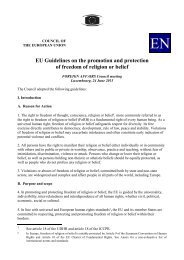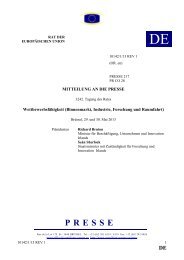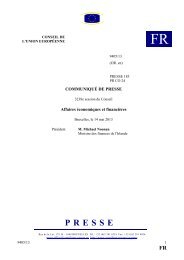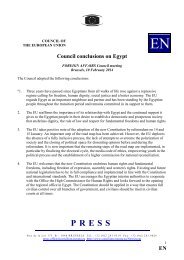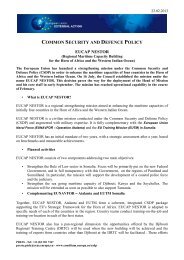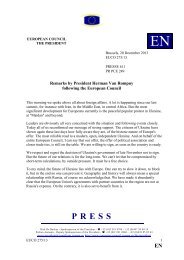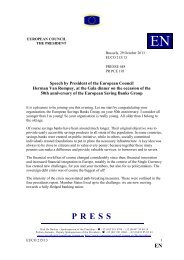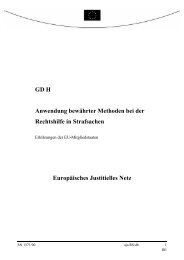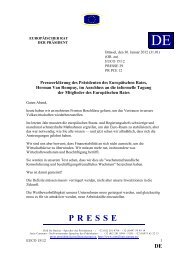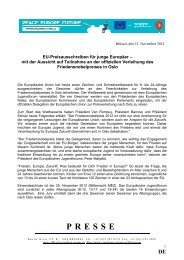14508/09 ADD 1 PL/vk 1 DG G COUNCIL OF THE ... - Europa
14508/09 ADD 1 PL/vk 1 DG G COUNCIL OF THE ... - Europa
14508/09 ADD 1 PL/vk 1 DG G COUNCIL OF THE ... - Europa
You also want an ePaper? Increase the reach of your titles
YUMPU automatically turns print PDFs into web optimized ePapers that Google loves.
Regarding the number of women and men senior/junior ministers by field of action, it is important<br />
to draw attention to the fact that socio-cultural functions, a function represented by a large pool of<br />
women senior/junior ministers, often go along with a large budget. To be involved in this field,<br />
therefore, is not necessarily a bad priority.<br />
Indicators 7 and 8: Indicators 7 and 8 concern the proportion of women civil servants in the two<br />
highest-ranking positions (after the minister) of ministries (appointed, elected or nominated) and<br />
their corresponding levels in the European Institutions. In 2008, women were represented in about a<br />
third (30.1 %) of the top two levels of the civil service in the MS compared to about a fourth in<br />
2003. In nine EU countries, women are more or less equally represented in the top ranks of the civil<br />
service (BG, SI, ES, SK, LV, HU, SE, RO, PO). In Denmark, Ireland, Cyprus, Belgium, Germany<br />
and Luxembourg men still dominate the senior positions in the top two tiers of the civil service. The<br />
EU Parliament consists of 41 % women civil servants at the top level, and the corresponding figure<br />
for the Council of the European Union is 15 %. With the exception of the Council of the European<br />
Union, progress has been made.<br />
Indicator 9: 'The proportion of women among judges of the Supreme Courts of the Member States<br />
and in the European Court of Justice and Court of First Instance has increased over time. In 1999,<br />
these bodies consisted of about 27 % women, and in 2008 that proportion had increased to 32 %. In<br />
seven MS, the Supreme Courts consist of 40 % women or more (LU, BG, RO, SK, HU, LV, SE). In<br />
five MS, these bodies consist of less than 10 % female representatives (ES, CY, UK, PT, MT).<br />
Indicators 10 and 11: The number of women among governors of the Central Banks of member<br />
States has remained minimal over the last five years. In 2003, one of the EU-15 countries had a<br />
female governor in the Central Bank (DK), and in 2008, no woman was appointed Central Bank<br />
Governor. However, when the distribution of women and men among the members of the central<br />
bank boards is taken into consideration, the proportion has changed slightly. In 2003, women<br />
accounted for 13 % of the members of central banks boards. In 2008, the proportion of women<br />
among members had increased to 17 %. Three MS have central banks with 30 % or more women in<br />
the board (FR, DK, FI), and Sweden is the only one with more than 40 % women. In contrast,<br />
central bank boards in Austria, Cyprus, Germany, Italy, Portugal and Slovenia are entirely male.<br />
<strong>14508</strong>/<strong>09</strong> <strong>ADD</strong> 1 <strong>PL</strong>/<strong>vk</strong> 102<br />
ANNEX <strong>DG</strong> G EN



